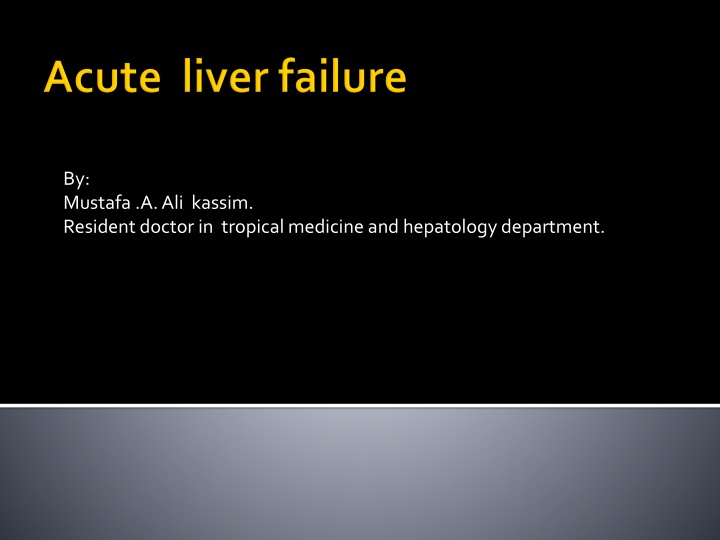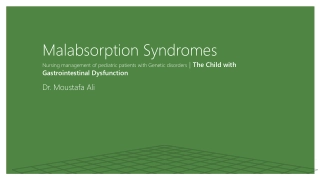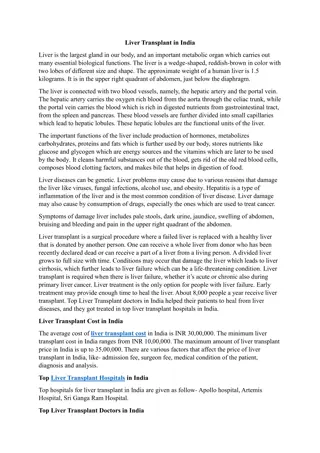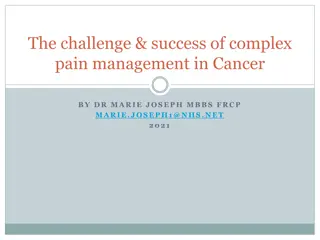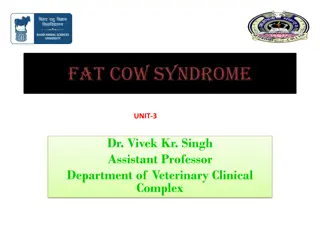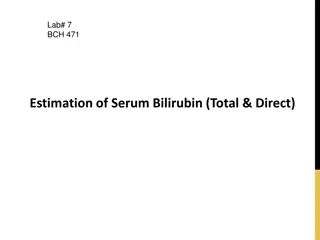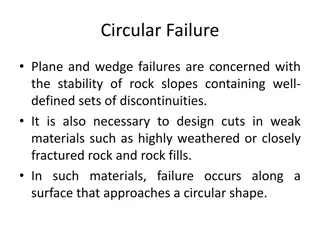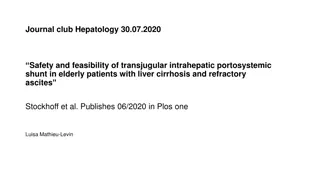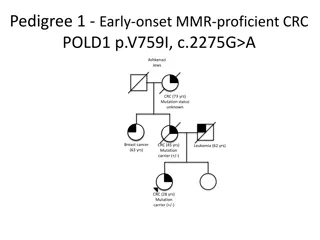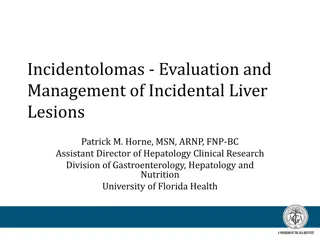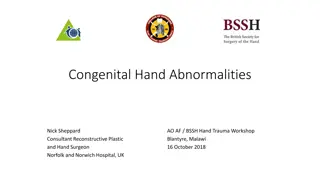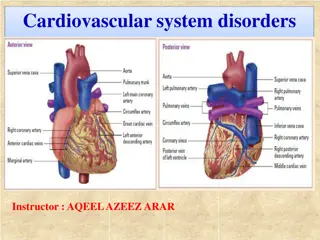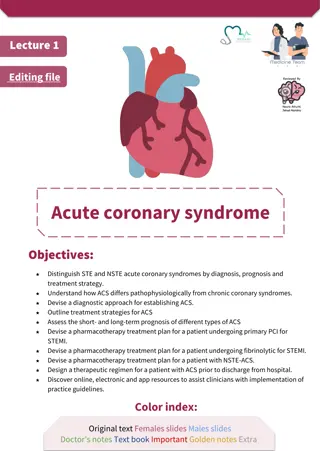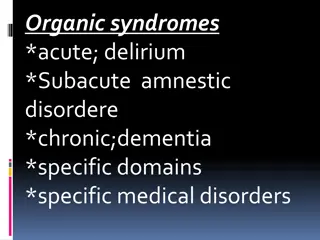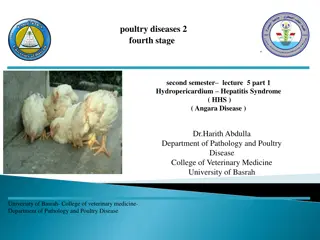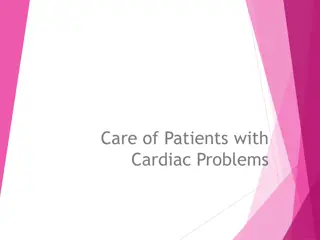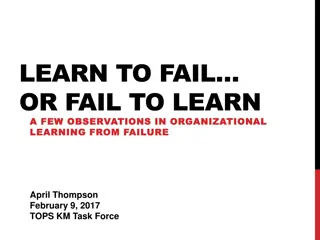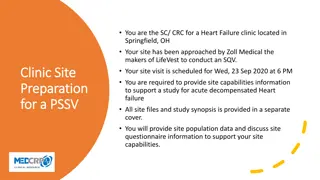Hepatic Failure Syndromes
Clinical syndrome characterized by rapid hepatic synthetic function failure leading to encephalopathy and coagulopathy in patients without prior liver disease history. Subtypes include hyperacute, acute, and subacute liver failure, each with different intervals and etiologies like viral hepatitis, drug toxicity, toxins, autoimmune hepatitis, and more.
Download Presentation

Please find below an Image/Link to download the presentation.
The content on the website is provided AS IS for your information and personal use only. It may not be sold, licensed, or shared on other websites without obtaining consent from the author.If you encounter any issues during the download, it is possible that the publisher has removed the file from their server.
You are allowed to download the files provided on this website for personal or commercial use, subject to the condition that they are used lawfully. All files are the property of their respective owners.
The content on the website is provided AS IS for your information and personal use only. It may not be sold, licensed, or shared on other websites without obtaining consent from the author.
E N D
Presentation Transcript
By: Mustafa .A. Ali kassim. Resident doctor in tropical medicine and hepatology department.
It is aclinical syndrome characterized by rapid failure of hepatic synthetic function with development of encephalopathy,and coagulopathy in patient withnopriorhistory ofliverdisease. jaundice, hepatic
Depending on the interval between the onset of jaundice and occurrence of encephalopathy 1-hyperacute type : interval less than 7 days Associated with :paractamoletoxicity, or fulminanthepatitis AorB. Has better prognosis . Increase incidence of cerebral edema.
2-acute type : Interval from 8 days up to 28 days. 3-subacute liver failure : Interval from 29 days to 12 weeks.
Varies according to the etiology and location . Viral hepatitis is the most common cause especially in Asia and developing countries. In the USA and Western countries drug toxicity is the main cause except Spain where HBV is the main cause.
Viral hepatitis: Hepatitis A,B,C,B+D,E. Herpes virus. Varicella zoster. Adeno virus. EBV. Cytomegalovirus. Parovirus.
Drug induced hepatitis: Acetaminophen toxicity Idiosyncratic drug response.. Anti TB drugs:isoniazide,pyrizina mide. Antifungal:ketokonazole Anticonvulsants: phenytoin,valporic acid.
Halothane . Antibiotics: tetracycline, (e.g.)ofloxacine,ciproflox . Ray s syndrome.
toxins Mushrum poisoning: Amanita or galerina types. Cocaine. Organic solvents. Phosphrus.
Auto immune hepatitis. Wilson disease. Malignancy with liver infiltration. Vascular disorders: Sinusoidal obstructive syndrome. Budd-chiari syndrome.
Pregnancy: Acute fatty liver of pregnancy. HE LLP syndrome. Ischemic hepatitis cardiogenic shock. Hypotension. Heat stroke. Heart failure . Pericardial diseases.
Acetaminophen: most common. -dose related. -it is metabolized by glucuronidation and sulfation ;a minority of the drug is metabolized by cyto-p450 leading to production of toxic intermediate (N-acetyl-P- benzoquinone)which is cleared by glutathione. In overdose glutathione is depleted.
Factors associated with increased risk for toxicity: 1-alcohol abuse. 2-barbiturate abuse. 3-poor nutrition. 4-age>40 years. 5-ass.viral hepatitis. 6-use of antidepressant drugs.
Characteristic feature of paracetmole toxicity is very high levels of ALT&AST with relatively low levels of bilirubin.
Hepatitis A virus: more in developing countries. Hepatitis B virus: HBsAg& IgM antibody to HBcAg may be present in the serum during the setting of acute infection; detection of HBV DNA is the most reliable test in ALF.Factors that icrease risk for fulmination include:
Co-infection with HDV. Co-infection with HCV. Chronic carrier who undergo chemotherapy or immunosuppressive therapy. Hepatitis C virus: rare. May occur with HAV super-infection or acetaminophen toxicity
Hepatitis D virus: with HBV hepatitis E virus: incidenceof ALF due to HEV increases with pregnancy with high mortality rate especially during the third trimester.
Herpes virus: HSV or VZv may lead to ALF in immunosuppresed patients.Cutaneouc lesions and DIC may occur. Liver biopsy shows viral inclusions. IV acyclovir therapy should be established immediately once diagnosed.
Other viruses: EBV. Adeno virus. Paro virus. CMV:in liver transplant recipients.
Usually diagnosed between 40&50 years. -AST to AlT ratio >2.2 with ALP to bilirubin level <4 these combined lab findings are sensitive and specific to Wilson disease. -decreased ceruloplasmine level ,increased serum cupper, and 24 h urine cupper, liver biopsy.kayser Fleisher ring .
Coombs negative hemolytic anemia and renal failure frequently occur due to elevated serum cupper. Emergency liver transplantation is indicated once diagnosed.
Rare cause of AlF occur in children with recent viral infection treated with aspirin . Sever vomiting , micro vesicular steatosis, with High incidence of cerebral edema and intracranial hypertension.
Non specific symptoms: anorexia ,malaise, nausea and vomiting. Jaundice. Hepatic encephalopathy. Reduction of liver size lead to marked impairment of liver function ,hypoglycemia, Co agulopathy, metabolic acidosis due to increased lactate level.
Tachycardia, hypotension ,hyperventilation ,and fever occur as signs of SIRS. Cerebral edema. Renal failure.
Sepsis: 1-afrequent complication up to 80%davelop bacterial infection and 30%fungal infections. 2-survillence cultures of blood, urine, and sputumShouldbeobtained. 3-anti microbial prophylaxis with impiric treatment should be initiated if any of the following occur:
Fever. Positive culture. Grade 3&4 encephalopathy. Hemodynamic instability. Patient listed for liver transplantation.
Renal failure: Occur as a result of hypovolaemia,acute tubular necrosis, or hapatorenal syndrome. It is a key prognostic indicator. Use of vassopressor therapy is initiated in the setting of circulatory dysfunction with hypotension. Renal replacement with continuous venovenous hemodialysis(cvvhd)is preferred if renal or circulatory failure occur.
Metabolic disorder: Hypoglycemia: d.t. glycogen production and Impaired gluconeogenesis.so frequent follow up of blood glucose level continuous infusion of 10%or20%glucose is done.
Hypophosphataemia. Metabolic acidosis. alkalosis: d.t. hyperventilation. Hypoxia: d.t. ARDS,aspiration,pulmonary haemorrage.patients with grade3&4 HE should undergo endo tracheal intubation.
Coagulopathy: Although it may be profound, serious bleeding events are uncommon. PPI to avoid GIT bleeding. Plasma,platlets ,or cryoprecipitate should be given if invasive maneuver. Vit k.
Encephalopathy: it may rapidly progress with cerebral edema and increased intracranial tension which occur frequently with grade 3&4 HE.
Cerebral edema: The most common cause of death. Hyper acute type are at greater risk of CE. Factors that contribute to cerebral edema include: hypoxia ,increased ammonia level that causes swelling of the astrocytes,systemic hypotension ,and decreased cerebral perfusion pressure.
Cerebral edema lead to ICP ,ischemic brain injury, and herniation. Clinically :abnormal papillary reflex ,muscular rigidity ,unconjugate eye movement, or decerebrate posturing(extension and hyperpronation of the arms with extension of the legs)
Hematology: CBC----WBc ,Hb level. Coagulation profile:PT ,PC,INR. Metabolic profile: ALT, AST, Albumin, proteins ,bilirubin level, ALP, sodium ,potassium, bicarb., calcium. Phosphate, glucose level. Creatinine. Ammonia, lactate level. Art. blood gases:PH,Po2,Pco2.
Virology: HBs Ag,HBc IgM. HAV antibody IgM. HCV antibody. HCV RNA. HEV IgM.(in endemic areas). HDV antibody(if HBV positive). EBV, CMV,HSV PCR.
Auto immune markers: ANA,ASMA. Toxicology :paracetamole level, alcohol level, urine drug screening. Microbiology: blood culture, urine culture and microscopy, sputum culture and microscopy. Imaging:abd sonar ,brain CT. Other:urinary cupper, pregnancy test.
Liver transplantation should be considered in all patients. Patients should be transferred to ICU once the presence of encephalopathy is established.
Management and prevention of the complications : sepsis Abs Renal failure vasopressor therapy and CVVHD. Hypoglycemia glucose infusion. Co agulopathy PPI,plasma,cryoprecipitate. Cerebral edema:
General measures: Reduction of stimuli. Head elevation 30 degrees. Intubation in HEg3&4. -specific measures: IV mannitol. Monitoring of ICP , initiation of hyperventilation Induced hypocapnea to promote cerebral vasoconstriction.
Acetaminophen toxicity :N-acetyl-cysteine. Viral hepatitis :anti viral therapy: -lamuvidine . -acyclovir. -gancyclovir. Autoimmune hepatitis: corticosteroid therapy.pt.not responding to ttt for 2 ws should be listed for transplantation. Wilson disease: liver transplantation is the only therapy. albumin dialysis and plasmapharesis ,can be initiated to decrease tubular damage until the graft become available.
Budd- chiari disease: anti co agulant therapy , Hepatic vein angioplasty, stent placement, Or trans jugular intra hepatic porto systemic shunt (TIPS) -acute fatty liver of pregnancy & sever pre eclampsia: delivery of the fetus.post partum transplantation may be required in some cases.
Depends on several factors: such as the etiology (paracetmoletoxicity ,HAV , ischemia, and pregnancy have better prognosis) and degree of HE. King s collage criteria: these criteria are characterized by high specificity for mortality however; failure to fulfill the criteria does not ensure survival
ALF due to acetaminophen toxicity : PH<7.30. or INR>6.5(PT>100)and serum creat.>3.4mg/dl in patients with grade 3or 4 encephalopathy. ALF not ass.with acetaminophine: INR>6.5(PT>100). Or any 3 of the following: 1-age<10 and>40yr. 2-duration between jaundice and encphalopathy>7days.
3-cause:nonA,nonBhepatitis or idiosyncratic drug reaction. 4-INR>3.5 (PT>50) 5-S.bilirubin>17.6mg/dl.
